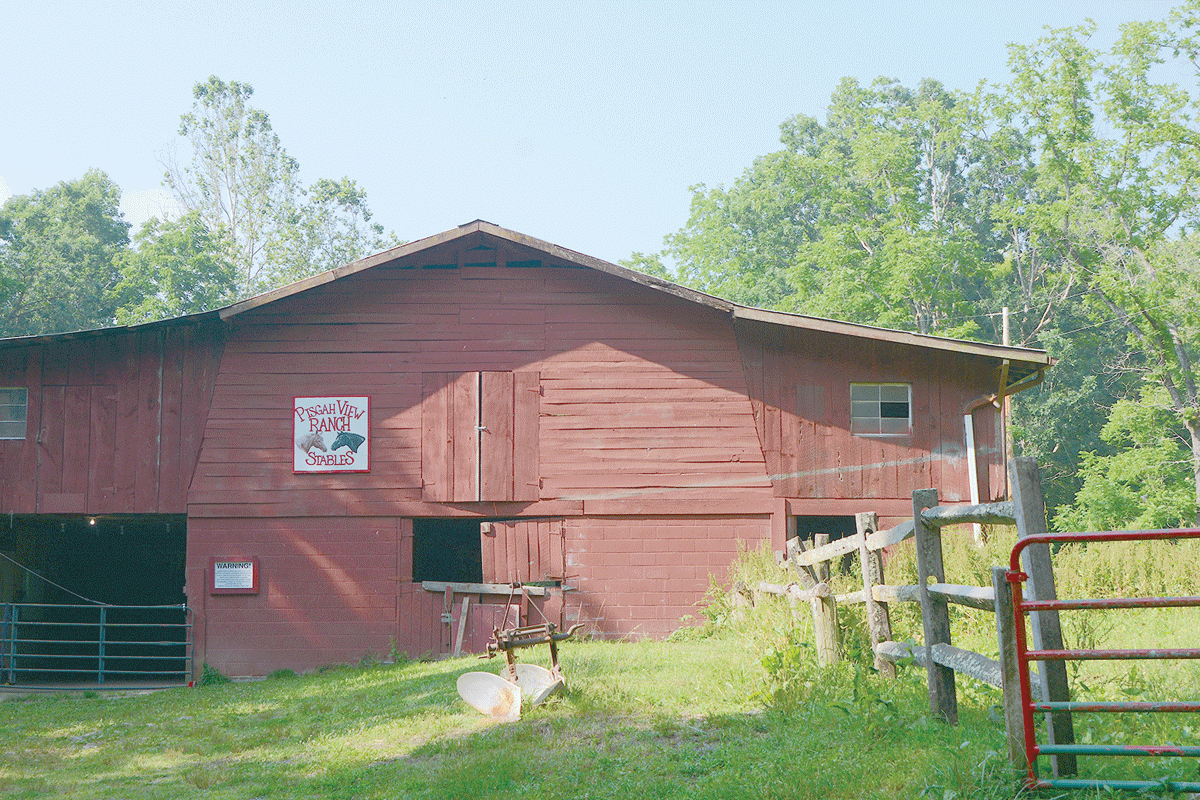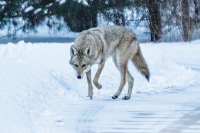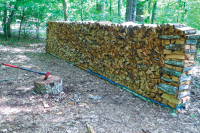Building the vision: Pisgah View State Park aims for 2025 open
 These stables were the staging ground for Pisgah View Ranch’s equestrian programs. Holly Kays photo
These stables were the staging ground for Pisgah View Ranch’s equestrian programs. Holly Kays photo
Harold McCarson isn’t surprised to see a deer standing in the road as he steps out of the familiar white farmhouse that served as the headquarters of Pisgah View Ranch for decades.
He’s also not surprised to see that the deer is not alone. Within moments, he’s spotted its fawn’s ears sticking up from the tall grass of the meadow and a congregation of wild turkeys gathered in the lawn on the opposite side.
“We’ve got so much wildlife,” he said. “They’re safe here. You can drive right by them, and they just stand there and look at you.”
Where the road ends, the wilderness begins. Beyond the pavement lies thousands of acres of undeveloped forestland covering the mountainous Buncombe-Haywood county line. The deer, turkey and countless other creatures living on the ranch property have all the space they need.
McCarson is one of the “Branchwater children” — the collection of Cogburn, Davis and McCarson kids who lived at the end of the branches coming out of the ranch. He was born and raised there, returning to the ranch for the last couple decades of his working life to take care of horses and whatever needed doing around the farm.
But all good things come to an end, and nearly 80 years after opening the ranch in 1941, the Cogburn family members who owned the property decided it was time to transition out of running the ranch. The land, a breathtaking 1,600 acres just south of Candler with clear views of Mount Pisgah, could have been divvied up for high-end housing.
Related Items
Instead, it became North Carolina’s newest state park.
“I’m so happy it’s turned into a park, it’s not being developed,” said McCarson, who is now a seasonal employee for the new Pisgah View State Park. “I played here when I was a kid and roamed these mountains, and I’d hate to have seen it get developed. Everybody’s happy right now with the way it’s turning out.”

The oldest building on the property was built in 1790 by Uriah Davis. Holly Kays photo
Building on history
Pisgah View State Park was officially created in 2019, but that enabling legislation didn’t include money to buy the land or do the work needed to open it to the public. The 2021 state budget bill provided funding to buy the land , and in 2022 the Parks and Recreation Trust Fund appropriated $300,000 for a 1.7-acre inholding at the park, as well as money for the master planning process that must be completed before the park opens. The park is expected to greet its first visitors in 2025.
At the helm of that effort is Pisgah View State Park’s first superintendent, Tyson Phillips, who was hired in September 2022. Like McCarson, he grew up in Candler and cares deeply about the place he’s charged with protecting.
“On Thursday nights, they would have square dancing at the lodge, barbeque,” he recalled. “So as kids we used to come over, and we used to hang out and run around. It was just a great community event, growing up. Of course, the food that they used to cook here — they had the traditional country cooking, breakfast, lunch and dinner. This place has a lot of sentimental value to a lot of different people that spent a lot of time here on vacations over the years.”
Its story goes back much further than the ranch’s opening in 1941. Five federally recognized tribes have ancestral connections to the land: the Muscogee Creek Nation, the Catawba Indian Nation and the three Cherokee tribes, which are the Eastern Band of Cherokee Indians, the Cherokee Nation and the United Keetoowah Band of Cherokee Indians. If the artifacts that McCarson has found buried in the garden at his home just down the road are any indication, a rich history is waiting to be uncovered there — he’s discovered an array of arrowheads, stone tools and a beautifully carved stone raven head while growing his vegetables over the years.
The family’s connection to the ranch dates back to 1790, when Uriah Davis acquired a land grant for the property.
“We’re going to try to build on that history,” Phillips said.
Right now, he’s trying to collect as much information as possible about what’s on the property and how it was used in years gone by so that the park can offer abundant education and interpretation opportunities to visitors.

Pisgah View State Park Superintendent Tyson Phillips (left) stands in front of headquarters with N.C. State Parks Planning Program Manager David Head. Holly Kays photo
The planning process
But there’s still a lot to do before scheduling opening day.
Right now, Pisgah View State Park is at the beginning of a master planning process that’s expected to take 18-24 months to complete. Asheville-based Equinox Environmental began the project in March.
Once complete, the master plan will lay out a 30-year vision for the park, identifying projects that must be completed immediately as a condition of getting the park open, and those to be prioritized in the longer term. The plan will also include cost estimates and financing options.
“A lot of that comes into the expertise of the division and the consultant, but also the input from stakeholders, both in the community and statewide, because state parks are statewide,” said David Head, Park Planning Program manager for N.C. State Parks. “But most importantly the input from the stakeholders here.”
Starting this fall, three public information meetings will take place to gather input from the public, which will be used to shape the plan. Planners are also interviewing various stakeholder groups — people interested in historic preservation, horseback riding and hiking, for example.
“A lot of that comes down to taking all those inputs and then figuring out what the park’s going to look like in the future,” Head said. “But also looking at the rich history that this park has, being the Pisgah View Ranch.”
Traditionally, the ranch property has had a lot of use from equestrians, hikers and campers. The plan will attempt to honor those traditions while also satisfying the parameters of how a state park must operate.
Students of the land
The consultant team is still working to inventory the natural and cultural resources the property holds.
“Right now they’re just in fact finding, looking at what’s out here, the flora, fauna, all that kind of stuff, getting familiar with the park,” Head said.

A bear’s print sinks into the mud on a trail. Holly Kays photo
It’s a big project. The ranch property totals more than 2.5 square miles, much of it mountainous, and none of it previously studied — formally, at least. McCarson and his extended family have been students of the land their whole lives.
Scooting along the trails on a State Parks ATV, McCarson navigates each bump and water crossing with ease. He stops the vehicle occasionally to point out a shrub whose inner bark can be used to draw out spider venom, a long cascade that becomes a gorgeous waterfall in high water or a spot that’s blanketed with trillium in the springtime. He knows every foot of the property’s 15 miles of horse trails like an old friend.
The park ranges from 2,600 feet in elevation where it bottoms out at the end of Pisgah View Ranch Road up to 4,600 feet as it approaches the ridge marking the boundary between Haywood and Buncombe counties. It contains five tributaries to Hominy Creek. Near the bottom, tulip-poplar trees grow in the draws, with berry bushes sprawling wherever a lapse in cover allows the sun to break through. Higher up, squirrels make a racket as they race down the drier slopes where oak trees stand tall.
McCarson wasn’t exaggerating when he spoke of the property’s diverse wildlife. By 10:30 a.m., the summer sun was already high and hot enough to keep most creatures resting until the evening’s cool, but evidence of their presence was easy to find. Recent rains left puddles and spots of mud in every dip of the trail, each one holding a collection of pawprints — bear, deer and raccoon.
The big picture
The conservation effort at Pisgah View isn’t just about the ranch’s 2,000 acres.
It’s part of a larger effort from the Southern Appalachian Highlands Conservancy, which facilitated the conservation purchase, to protect the forested but privately owned land along the Haywood-Buncombe county line from future development. The ranch is adjacent to other permanently conserved lands that connect it to more than 120,000 contiguously protected acres, including the Pisgah National Forest, the Blue Ridge Parkway, private conservation easements and state game lands.
“We’re going to keep adding property,” Phillips said. “As the park continues to grow, we’re having more landowners approach us that adjoin the property, that are willing to sell to the state, because they want to see it preserved. Nobody wants to see houses on these ridgelines.”
Eventually, he said, he’d love to see land conservation and trail building efforts connect Pisgah View State Park to Canton’s new Chestnut Mountain Nature Park . As the crow flies, the two are less than 5 miles apart, though the shortest driving route totals 13.5 miles.
A big part of Phillips’ job thus far has been going out on the land to mark boundaries and make “good contacts” with surrounding landowners.
“We’ve been pretty successful at it so far,” he said, though noting some neighbors have concerns about issues like traffic volume after the park opens.
Before Pisgah View can expand its acreage, it must solidify the acres it already has. Some of the property has been officially conveyed to N.C. State Parks, while other parcels are still in progress. In all, the initial park will total 1,600 to 2,000 acres, depending on final measurements from the land survey.
Once the acquisitions are complete and the master plan final, the park will turn its attention to securing funding to carry out the plan. One of the most expensive — but most important — items will be updating the underground utilities at the bottom of the property. The park will likely open with limited inital amenities.

McCarson shows the collection of artifacts he’s found on his nearby property. Holly Kays photo
The N.C. Parks and Recreation Trust Fund will likely be a major source of funding. Additionally, N.C. State Parks is typically budgeted $8-9 million for such projects, to be shared among all 42 parks. The state legislature could also decide to speed development by granting a special pot of funding.
There are still hurdles to jump, but those involved with the process believe they’re worth jumping.
“The backcountry here is gorgeous,” Head said. “You get up there and you get what truly the Southern Appalachian mountains feel like and should be.”












